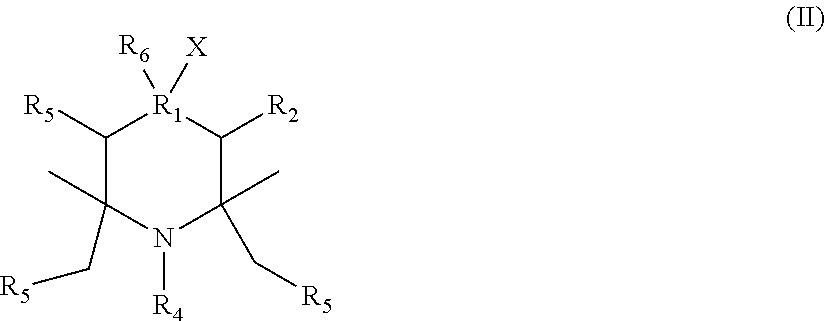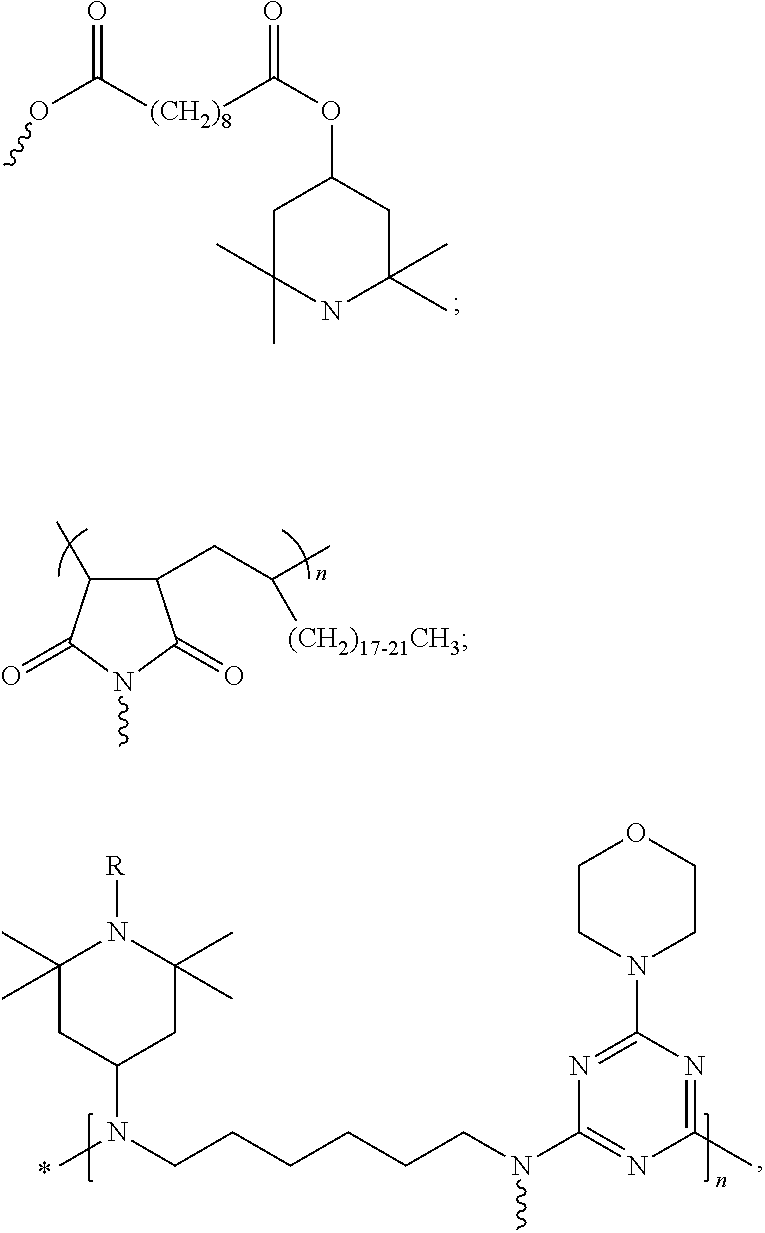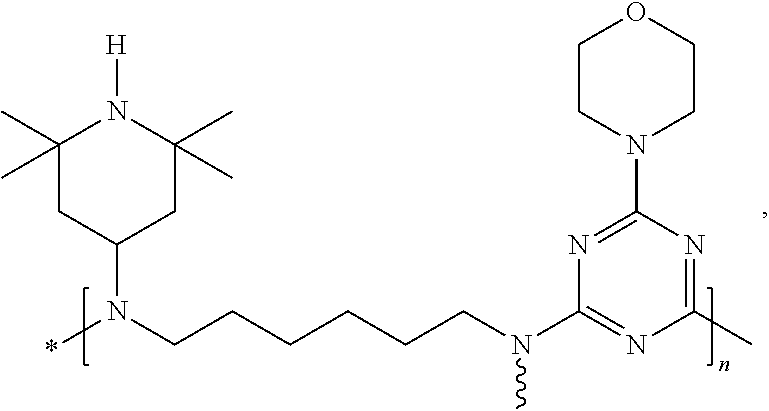UV Stabilization of Isosorbide Polycarbonates
a technology of isosorbide polycarbonate and stable uv, which is applied in the direction of liquid carbonaceous fuels, petroleum industry, manufacturing tools, etc., can solve the problems of limited choice, brittleness of original ductile polycarbonate, and general problem of light-induced degradation
- Summary
- Abstract
- Description
- Claims
- Application Information
AI Technical Summary
Benefits of technology
Problems solved by technology
Method used
Image
Examples
example 1
HALS-Stabilized Polycarbonate
[0256]Several different polycarbonate resins containing UV absorbers and / or HALS compounds were screened for increased stability in the presence of UV irradiation. The compositions of these resins are shown in Tables 1a and 1b.
TABLE 1asamplesamplesamplesamplesamplesamplesamplesamplebatch #1#2#3#4#5#6#7#8#9Isosorbide polycarbonate%93.2793.2793.2793.2793.2793.2793.2793.2793.27copolymer 1MBS impact modifier%666666666Antioxidant 1076%0.40.40.40.40.40.40.40.40.4PETS%0.30.30.30.30.30.30.30.30.3NaOH, 33% in H2O%0.030.030.030.030.030.030.030.03Coated Titanium Dioxide%444444444Pigment blue 28%0.0320.0320.0320.0320.0320.0320.0320.0320.032Copper Phthalocyanine%0.000170.000170.000170.000170.000170.000170.000170.000170.00017Pigment Blue 15:4Pigment Red 101%0.0080.0080.0080.0080.0080.0080.0080.0080.008UVA 234%0.15UVA 5411%0.150.15CYASORB UV-3638%0.150.15HALS 770%0.150.150.150.15Uvinul 3030%0.15
TABLE 1bsamplesample#10#11sample #12Polycarbonate resin 1, MVR 6%4.654.6546...
example 2
HALS-Stabilized Polycarbonate
[0285]Several different polycarbonate resins containing UV absorbers and / or HALS compounds were screened for increased stability in the presence of UV irradiation. See Tables 3ab and 4. The ΔE values are a measure of the color difference between a color plaque of that material before and after the UV exposure test. The test was executed on plaques molded under ‘standard’ and ‘abusive’ conditions. Both values are reported in the table. It was found that the standard deviation in ΔE over a longer period of time (multiple test periods) was significantly higher (˜0.3) than the standard deviation on a particular sample within a particular test sequence / sample set. Therefore a comparison of ΔE values between examples 1 and 2 is not desired.
[0286]Molding of the isosorbide based compositions (sample #14-24) was done after drying the material for 4 hrs at 85° C. in an air circulating oven and using a barrel temperature of 250° C. and a residence time of 120 s (st...
example 3
HALS Showing No Improvement
[0298]
TABLE 6sample #25sample #26sample #27sample #28sample #29sample #30sample #31Isosorbide polycarbonate%99.997799.697799.497799.397799.097799.397799.0977copolymer 1UVA 234%0.30.45UVA 5411%0.150.50.30.45HALS 770%0.150.30.450.30.45H3PO3 (45% in water)%0.00230.00230.00230.00230.00230.00230.0023
[0299]All percentages in Table 6 refer to weight percentages. Components are described near table 1. H3PO3 is used in a 45% solution in water. The mass percentages in the table refer to the solution, not to the pure component.
[0300]Molding took place under standard conditions which are the same as the standard conditions described for examples 1 and 2.
[0301]Table 7 indicates a number of polycarbonate compositions in which no colorants or impact stabilizers are used. These transparent materials were subjected to the same UV aging test as the samples in example 1 and example 2. ΔE values are reported in table 7. Sample #25 is a reference material. It is the pure isoso...
PUM
| Property | Measurement | Unit |
|---|---|---|
| Fraction | aaaaa | aaaaa |
| Percent by mass | aaaaa | aaaaa |
| Percent by mass | aaaaa | aaaaa |
Abstract
Description
Claims
Application Information
 Login to View More
Login to View More - R&D
- Intellectual Property
- Life Sciences
- Materials
- Tech Scout
- Unparalleled Data Quality
- Higher Quality Content
- 60% Fewer Hallucinations
Browse by: Latest US Patents, China's latest patents, Technical Efficacy Thesaurus, Application Domain, Technology Topic, Popular Technical Reports.
© 2025 PatSnap. All rights reserved.Legal|Privacy policy|Modern Slavery Act Transparency Statement|Sitemap|About US| Contact US: help@patsnap.com



